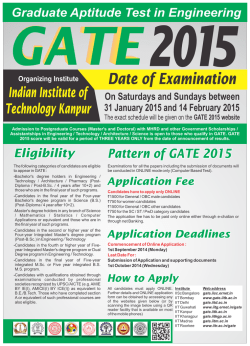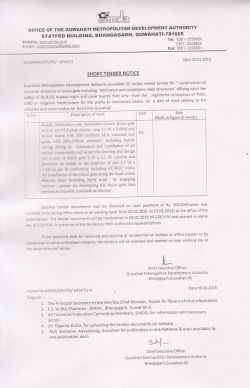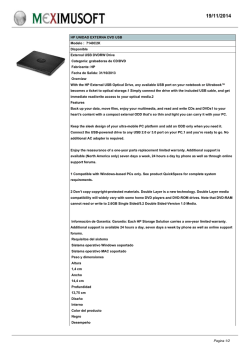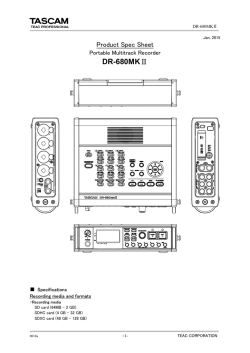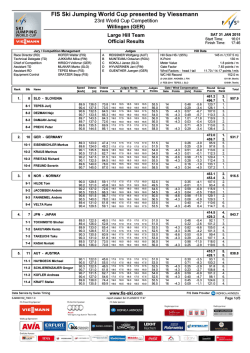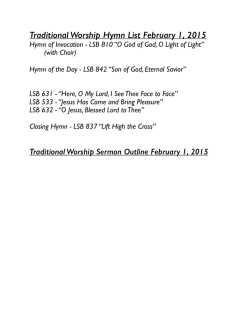
Manual - Robust-Packet
2015-01-28 Robust-Packet-Network Manual RPR-HF-APRS compiled by DF8LS Robust-Packet-Network www.robust-packet.net Manual update 2015-01-28 08h00z Index Introduction......................................................................................................... 2 Bulletin Board ...................................................................................................... 3 RPR-Network Europe ............................................................................................ 4 RPR-Frequencies Europe....................................................................................... 5 HF-APRS Frequency Calculation............................................................................. 6 HF-APRS Frequencies Worldwide........................................................................... 7 RPR-IGATE .......................................................................................................... 8 UI-View............................................................................................................ 8 APRSIS32 ......................................................................................................... 9 SCS Tracker.................................................................................................... 15 RPR-MOBILE ...................................................................................................... 16 UI-View.......................................................................................................... 16 SCS Tracker.................................................................................................... 17 RPR – Theory..................................................................................................... 19 RPR-users Europe .............................................................................................. 24 RPR-users outside Europe................................................................................... 26 Introduction The following are the results and preliminary status quos of an open exchange between the RPR users summarized in this manual. It is the goal of Robust-Packet-Network to make Robust Packet Radio more popular within the HF-APRS community and to strengthen the network. Here the focus is set on frequencies and broadcast times in the network, as well as configurations of digipeaters, mobile and fixed stations. Settings in UI-View and the SCS Tracker / DSP Module II are represented here as an example. All given datas and statements are matter of constant changes and will be varied towards the needs and requirements of all users. 2-26 Robust-Packet-Network www.robust-packet.net Manual update 2015-01-28 08h00z Bulletin Board Latest SCS Tracker firmware 1_4k.trk is available here http://robust-packet.net/SCS-Tracker-Firmware.zip Latest TRConfig to use firmware can be found here http://www.scs-ptc.com/downloads/trconfig-1 If you like to operate reciprocal between FSK and RPR please note the following. This operational mode of the SCS Trackers is called alternate mode or mixed mode by some hams. SCS Tracker’s manual uses the term toggle mode . This modus is the main reason for wishes to keep 20m operation in LSB. Toggle mode provides a power cut between beacons with a deaf receiver. The latest dual mode operates continuously on a main selected modulation. The beacon transmission then comes twice with the second one being the other modulation before jumping back to the main selected one. So you can listen and transmit continuously on RPR but (as safeguard) transmit a FSK beacon on top. The manual has a section explaining specifics in APRSIS32. Even if here just mentioned under IGATE it is feasible for mobile usage as well (including Moving Map Function). www.Robust-Packet.net is ’on air’. If you like to obtain an email adress [email protected] feel free to request. An instant rerouting to your known standard email adress would immediately be in effect. To make RPN more popular please consider to implement http://robust-packet.net in your Comment [%AC] (SCS Tracker) / Beacon Comment (UIView). Since it is quiet long for 300 baud operation a 2m transmission would help as well. Daily developements and corrections can be found online here ! http://www.robust-packet.net/Robust-Packet-Network-Manual.pdf 3-26 Robust-Packet-Network www.robust-packet.net Manual update 2015-01-28 08h00z RPR-Network Europe RPN-N (Robust-Packet-Network-North) 30 m DF8LS-10 Schleswig-Holstein 30 m DL5CG-10 Mecklenburg-West Pomerania 30 m OH6DL-10 Western Finland Gate/- RF-INT-RF HX & QRU-Server operational Gate/- RF-INT HX operational Gate/Digi RF-INT HX operational RPN-W (Robust-Packet-Network-West) 30 m GM4WMM-10 Gate/- RF-INT-RF HX operational Orkney Islands RPN-E (Robust-Packet-Network-East) 30 m Z38D-10 F.Y.R.O.Macedonia Gate/Digi RF-INT-RF H24 operational RPN-C (Robust-Packet-Network-Central) 30 m DH8HP-1 North Rhine-Westphalia 30 m DK2EZ-10 Hesse 40 m DK2EZ-10 Hesse Gate/- RF-INT-RF HX operational Gate/Digi RF-INT-RF H24 Parallel-Crosspeater 40m operational Gate/Digi RF-INT-RF H24 Parallel-Crosspeater 30m operational RPN-S (Robust-Packet-Network-South) non-standard 14.102,00 kHz USB 20 m DB0UAL-10 Bavaria 20 m OE3XUR Lower Austria 30 m OE3XUR Lower Austria 30 m IQ2LB-7 Lombardy 30 m IR0UGN-10 Province of Rome 30 m HB9DDF-10 Canton Aargau 30 m HB9ZF-10 Canton Zurich 80 m DB0UAL-10 Bavaria 80 m HB9ZF-10 Canton Zurich H24 = 24 hours operation H12 = except night hours Gate/Digi RF-INT H24 operational Gate/Digi RF-INT-RF H24 operational Gate/Digi RF-INT-RF H24 operational Gate/Digi RF-INT-RF H24 operational - /Digi RF-INT-RF H24 operational Gate/Digi RF-INT-RF HX operational Gate/Digi RF-INT-RF H12 operational Gate/Digi RF-INT H24 operational Gate/Digi RF-INT-RF HN operational HX = variable times / on request HN = night times Comment The interest in operating specific frequencies are as widely spread as the applications the users prefer. Long-distance travelers focus 20 & 30 m band. Within Europe 80 m is regarded as a valuable band as well. First it means that HF-APRS activities are not over after sunset and second it 4-26 Robust-Packet-Network www.robust-packet.net Manual update 2015-01-28 08h00z lets participate lower class licensed hams. Long –distance mobile stations may claim antenna problems but in an area between 500-1000 km even short monoband antennas have shown excellent results. Agreement among all hams is not to loose each other on too many different frequencies. Anyway new activities raised up on 40 m. After changing IARU bandplan towards 7.0007.200 kHz the digimode part in the IARU Region 1 went up as well. Till now no new specific frequencies have been announced. In order to stay clear of the CW area the new frequncies 7.047,30 kHz USB for RPR respectively 7.047,60 kHz USB for FSK (HFP) have been developed. Efforts to find a worldwide 40 m frequency failed due to IARU bandplan differences. In theory there are APRS frequencies existing as well in the 10 m, 15 m and 17 m areas but no gate or digipeater infrastructor is to be found there. So in order to concentrate activities those frequencies are no longer mentioned in this document. RPR-Frequencies Europe 20 m 14.103,30 kHz LSB 30 m 10.147,30 kHz USB 40 m 7.047,30 kHz USB 80 m 3610,00 kHz USB DB0UAL 14.102,00 kHz USB Comment (according to OE3MZC) 14.103,30 kHz LSB – For RPR on 20m it is essential to use DIAL-QRG 14.103,30 kHz LSB (lower sideband !). Just under these conditions "TOOGLE-MODE" (alternate mode / mixed mode) provided by the SCS DSP-TNCs operates and is compartible with the international HF-APRS-QRG for FSK (HFP) 300baud. RPRsignals operate a center-frequency of 1500Hz while FSK300 signals center at 2000Hz and by this intercept the right frequency. It has to be pointed out that due to usage of OFDM modulation selective sideband is in effect. In other words LSB is to be received on LSB only (USB on USB) whilst the old FSK300 HFAPRS signal is receivable on USB and LSB at the same time by adjusting the dial-QRG. 10.147,30 kHz USB – The only really common frequency worldwide including sideband selection. FSK frequency is 10.147,60 kHz USB and TOOGLE-MODE is possible as well. 5-26 Robust-Packet-Network www.robust-packet.net Manual update 2015-01-28 08h00z 7.047,30 kHz USB – The new frequency in the 40 m band. Tests will take place and in the long run it is kept available for periodes of low solar activities. The specific Dial-QRG is a good reminder reflecting the 30 m one and fullfills the conditions according the IARU Region 1 bandplan. 3.610,00 kHz USB – The traditional frequency from Bavaria. For years DB0UAL(-10) has done a reliable job single handedly. Meanwhile a wider interest is aroused. Especially after sunset many stations join a ’fly-in’. Since no specific path setting for DB0UAL(-10) is required any longer other gates enjoy the interaction. HF-APRS Frequency Calculation HF-APRS Dial Frequency Calculation RPR FSK Tone Frequencies 1600/1800 Region RPR USB=300 Hz lower than FSK LSB=300 Hz higher than FSK FSK USB=300 Hz higher than RPR LSB=300 Hz lower than RPR side band 14.103,00 kHz LSB 20 m Europe 14.103,30 kHz 20 m VK /ZL 14.096,30 kHz 14.096,60 kHz USB 10.147,30 kHz 10.147,60 kHz USB 40 m Europe 7.047,30 kHz 7.047,60 kHz USB 40 m PY / VK / ZL 7.036,30 kHz 80 m DL 3.610,00 kHz 30 m worldwide 7.036,00 kHz LSB 3.610,30 kHz USB = no usage BOLD = active usage www.robust-packet.net/tipsandtricks/HF-APRS-Frequency-Calculation.pdf for details Own Station HF-APRS Dial Frequency Calkulation RPR FSK Tone Frequencies _ _ _ _ / _ _ _ _ Band RPR USB=300 Hz lower than FSK LSB=300 Hz higher thanFSK FSK USB=300 Hz higher than RPR LSB=300 Hz lower than RPR side band 20 m 14.1 _ _ , _ _ kHz 14.1 _ _ , _ _ kHz LSB 30 m 10.1 _ _ , _ _ kHz 10.1 _ _ , _ _ kHz USB 40 m 7.0 _ _ , _ _ kHz 7.0 _ _ , _ _ kHz USB 80 m 3.6 _ _ , _ _ kHz 3.6 _ _ , _ _ kHz USB 6-26 Robust-Packet-Network www.robust-packet.net Manual update 2015-01-28 08h00z HF-APRS Frequencies Worldwide chart as download image under www.robust-packet.net/hf-aprs-worldwide-chart.html Comment North America (red) Main activities take place on the 30 m band. No further information could be found so far concerning the other bands. According to WA8LMF the density of gates in North America is such high that digipeating is undesirable. A point of view that can be found in Europe as well. Anyway we have to keep on mind that i.e. mobile stations with a distance of 100-200 km to each other would never learn their proximity. With flat tires in the middle of nowhere digipeating then gets a different touch... When RPR traffic starts now in North America a path APRS,WIDE1-1 is recommended. FSK (HFP) traffic does not encounter any influence by RPR ! Europe (orange) – see comment on previous page Africa (yellow) Only activities observed are on the 30 m band. It is known that RPR gates are offered as well. Whether that is upon request and therefore temporary only is matter of survey. Oceania (green) – Driving force when it comes to HF-APRS are the Australian hams. Specifics here are the different frequencies on 20 m & 40 m compared to Europe and different side 7-26 Robust-Packet-Network www.robust-packet.net Manual update 2015-01-28 08h00z band selection as well. The historical developement doing HF-APRS came by the usage of old commercial radios. Those provided only USB and so 20 m was kept USB ever since. Shown RPR frequencies are theoretical entries only for the time being but hams down there are highly interested to enter the community of robust packet users. General statement about path setting in South Africa and Australia – In those areas gating to the internet takes place via crossgating to the VHF-net. So by using GATE and then WIDEN-n results in the nessecary hops to the VHF IGATE. RPR-IGATE UI-View [with unmodified original program] Visit http://df8ls.de/newn-n-paradigm-english.html Beacon Comment – meaning features G/D Gate & Digi available -/D Digi only G/- Gate only connectivity R-I-R Radio Internet Radio connection R-I Radio Internet only R Radio only / no internet i.e. Digi/p time table H24 24 hours operation H12 except night hours HX variable times / on request HN night times 8-26 Robust-Packet-Network www.robust-packet.net Manual update 2015-01-28 08h00z SCS-Tracker Comment [%AC] UI-View Beacon Comment aprs.fi - presentation Comment text under APRS Settings under Station Setup 1. line ( green) in the bubble http:// and mailto: links are always blue mobiles show this in moving list Report Text [%AR] Status Text under APRS Settings under Status Text http://aprs.fi/moving/ Status message 2. line (magenta) in the bubble http:// und mailto: links are always blue not shown in the moving list Result in the internet APRSIS32 There are no specific entries to be done in the menus of the APRSIS32 program to operate RPR with the SCS Tracker. Even the 300 bauds are automatically selected as configured in the tracker itself when entering the KISS mode. To reach the KISS mode you first create a new port with KISS as choice. The name 'SCS' is free selectable. Then you exchange directly in the XML file anything between <OpenCmd> ... and ...</CloseCmd> with the actual example below. This is done straight with the txt editor. If you wish to digipeat this is done in the XML as well in the line after the very last radio port !!! you created. (see example) Menu Setting Range maximum is 1000 mi / 1609 km Unter Add Filter you may enter callsigns that go beyond that range i.e. b/KJ4ERJ* Comment may be changed here as well 9-26 Robust-Packet-Network www.robust-packet.net Manual update 2015-01-28 08h00z Crucial to the function as GATE is the tick in RF to IS. Whoever is ticking IS to RF becomes a bidirectional IGATE, though APRS-IS is configured in the same manner. Without the RF to IS setting here in APRS-IS gating would not work. Corresponding IS to RF when the bidirectional function is desired. Don't forget to enable, either here or in the menu of the program. SCS Tracker KISS Mode & Digipeating - XML file <!--RFPort[0]--> check your values! <RFPort Name="10.1473"> using this port name here i.e. for 30m results in DX reports incl. valid frequency <Protocol>KISS</Protocol> <Device>COM6:38400,N,8,1</Device> check your values! <RfBaud>300</RfBaud> <OpenCmd>^027~!!0</OpenCmd> <OpenCmd>^064^075!!0</OpenCmd> <CloseCmd>^192^255^192~!!1</CloseCmd> <CloseCmd>^027~!!0</CloseCmd> <QuietTime>0</QuietTime> <Enabled>1</Enabled> <XmitEnabled>1</XmitEnabled> <ProvidesNMEA>1</ProvidesNMEA> <RFtoISEnabled>1</RFtoISEnabled> <IStoRFEnabled>1</IStoRFEnabled> <MyCallNot3rd>0</MyCallNot3rd> <BeaconingEnabled>1</BeaconingEnabled> <BeaconPath></BeaconPath> <BulletinObjectEnabled>1</BulletinObjectEnabled> <DXEnabled>0</DXEnabled> <DXPath>RFONLY</DXPath> <MessagesEnabled>1</MessagesEnabled> <MessagePath></MessagePath> <TelemetryEnabled>0</TelemetryEnabled> <TelemetryPath></TelemetryPath><!--DigiXform--> do N O T change this line (under development) </RFPort> <!--RFPort[0]--> check your values! <!--RFPort[1]--> <RFPort Name="... ... <!--DigiXform--> </RFPort> <!--RFPort[1]--> check your values! do N O T change this line (under development) check your values! <!--DigiXform--> exchange this line with <DigiXform>WIDE1-1=WIDE1*</DigiXform> if you wish to digipeat. Otherwise leave it untoughed. 10-26 Robust-Packet-Network www.robust-packet.net Manual update 2015-01-28 08h00z Using the settings mentioned above lets the SCS Tracker easily enters KISS mode and exits back to stand alone operation. Anyhow, when restarting APRSIS32 it is vital to switch the tracker powerless for a second (under investigation). SCS PTC-IIIusb KISS Mode - XML file <!--RFPort[0]--> check your values! <RFPort Name="10.1473"> using this port name here i.e. for 30m results in DX reports incl. valid frequency <Protocol>KISS</Protocol> <Device>COM6:38400,N,8,1</Device> check your values! <RfBaud>300</RfBaud> <OpenCmd>^027~!!1</OpenCmd> <OpenCmd>^M~!!1</OpenCmd> <OpenCmd>QUIT!cmd:</OpenCmd> <OpenCmd>PSKA 250</OpenCmd> check your values! <OpenCmd>TONES 2</OpenCmd> <OpenCmd>TRX Frequency 10147.3</OpenCmd> <OpenCmd>PAC!pac:</OpenCmd> <OpenCmd>BAUD r300!pac:</OpenCmd> <OpenCmd>^064^075!!0</OpenCmd> <CloseCmd>^192^255^192~!!2</CloseCmd> <CloseCmd>^M~!pac:!1</CloseCmd> <CloseCmd>QUIT!cmd:</CloseCmd> <QuietTime>0</QuietTime> <Enabled>1</Enabled> <XmitEnabled>1</XmitEnabled> <ProvidesNMEA>1</ProvidesNMEA> <RFtoISEnabled>1</RFtoISEnabled> <IStoRFEnabled>1</IStoRFEnabled> <MyCallNot3rd>0</MyCallNot3rd> <BeaconingEnabled>1</BeaconingEnabled> <BeaconPath></BeaconPath> <BulletinObjectEnabled>1</BulletinObjectEnabled> <DXEnabled>0</DXEnabled> <DXPath>RFONLY</DXPath> <MessagesEnabled>1</MessagesEnabled> <MessagePath></MessagePath> <TelemetryEnabled>0</TelemetryEnabled> <TelemetryPath></TelemetryPath> <!--DigiXform--> </RFPort> <!--RFPort[0]--> check your values! 11-26 Robust-Packet-Network www.robust-packet.net Manual update 2015-01-28 08h00z SCS PTC-IIex KISS Mode - XML file check your values! <!--RFPort[0]--> <RFPort Name="10.1473"> using this port name here i.e. for 30m results in DX reports incl. valid frequency <Protocol>KISS</Protocol> <Device>COM6:38400,N,8,1</Device> check your values! <RfBaud>300</RfBaud> <OpenCmd>^027~!!1</OpenCmd> <OpenCmd>^M~!!1</OpenCmd> <OpenCmd>Q!cmd:</OpenCmd> <OpenCmd>TONES 4!cmd:</OpenCmd> <OpenCmd>BRIGHT 6!cmd:</OpenCmd> <OpenCmd>PSKA 240!cmd:</OpenCmd> check your values! <OpenCmd>PAC!pac1:</OpenCmd> <OpenCmd>USER 0!pac1:</OpenCmd> <OpenCmd>PRBOX 0!pac1:</OpenCmd> <OpenCmd>BAUD R300!pac1:</OpenCmd> <OpenCmd>^064^075!!0</OpenCmd> <CloseCmd>^192^255^192~!!2</CloseCmd> <CloseCmd>^M~!pac1:!1</CloseCmd> <CloseCmd>Q!cmd:</CloseCmd> <QuietTime>0</QuietTime> <Enabled>1</Enabled> <XmitEnabled>1</XmitEnabled> <ProvidesNMEA>1</ProvidesNMEA> <RFtoISEnabled>1</RFtoISEnabled> <IStoRFEnabled>1</IStoRFEnabled> <MyCallNot3rd>0</MyCallNot3rd> <BeaconingEnabled>1</BeaconingEnabled> <BeaconPath></BeaconPath> <BulletinObjectEnabled>1</BulletinObjectEnabled> <DXEnabled>0</DXEnabled> <DXPath>RFONLY</DXPath> <MessagesEnabled>1</MessagesEnabled> <MessagePath></MessagePath> <TelemetryEnabled>0</TelemetryEnabled> <TelemetryPath></TelemetryPath> <!--DigiXform--> </RFPort> <!--RFPort[0]--> check your values! 12-26 Robust-Packet-Network www.robust-packet.net Manual update 2015-01-28 08h00z SCS PTC-P4dragon KISS Mode - XML file <!--RFPort[0]--> check your values! <RFPort Name="10.1473"> using this port name here i.e. for 30m results in DX reports incl. valid frequency <Protocol>Simply(KISS)</Protocol> ! ! ! not KISS <Device>COM2:38400,N,8,1</Device> check your values! <RfBaud>300</RfBaud> <OpenCmd>^027~!!1</OpenCmd> <OpenCmd>^M~!!1</OpenCmd> <OpenCmd>Q!cmd:</OpenCmd> <OpenCmd>TONES 4!cmd:</OpenCmd> <OpenCmd>BRIGHT 6!cmd:</OpenCmd> <OpenCmd>PSKA 140!cmd:</OpenCmd> check your values! <OpenCmd>PRBOX 0!pac:</OpenCmd> <OpenCmd>PAC!pac:</OpenCmd> <OpenCmd>USER 0!pac:</OpenCmd> <OpenCmd>BAUD R300!pac:</OpenCmd> <OpenCmd>^064^075!!0</OpenCmd> <CloseCmd>^192^255^192~!!2</CloseCmd> <CloseCmd>^M~!pac:!1</CloseCmd> <CloseCmd>Q!cmd:</CloseCmd> <QuietTime>0</QuietTime> <Enabled>1</Enabled> <XmitEnabled>1</XmitEnabled> <ProvidesNMEA>0</ProvidesNMEA> <RFtoISEnabled>0</RFtoISEnabled> <IStoRFEnabled>0</IStoRFEnabled> <MyCallNot3rd>0</MyCallNot3rd> <NoGateME>0</NoGateME> <BeaconingEnabled>1</BeaconingEnabled> <BeaconPath>WIDE1-1</BeaconPath> <BulletinObjectEnabled>1</BulletinObjectEnabled> <DXEnabled>0</DXEnabled> <DXPath>WIDE1-1</DXPath> <MessagesEnabled>1</MessagesEnabled> <MessagePath>WIDE1-1</MessagePath> <TelemetryEnabled>0</TelemetryEnabled> <TelemetryPath>WIDE1-1</TelemetryPath> <!--DigiXform--> </RFPort> <!--RFPort[0]--> check your values! 13-26 Robust-Packet-Network www.robust-packet.net Manual update 2015-01-28 08h00z AGWmodem with PTC-IIex - XML file <!--RFPort[0]--> check your values! <RFPort Name="10.1473"> using this port name here i.e. for 30m results in DX reports incl. valid frequency <Protocol>AGW</Protocol> <Device>@localhost:8000</Device> <RfBaud>300</RfBaud> <!--OpenCmd--> <!--CloseCmd--> <QuietTime>0</QuietTime> <Enabled>1</Enabled> <XmitEnabled>1</XmitEnabled> <ProvidesNMEA>0</ProvidesNMEA> <RFtoISEnabled>0</RFtoISEnabled> <IStoRFEnabled>0</IStoRFEnabled> <MyCallNot3rd>0</MyCallNot3rd> <NoGateME>0</NoGateME> <BeaconingEnabled>1</BeaconingEnabled> <BeaconPath>WIDE1-1</BeaconPath> <BulletinObjectEnabled>1</BulletinObjectEnabled> <DXEnabled>0</DXEnabled> <DXPath>RFONLY</DXPath> <MessagesEnabled>1</MessagesEnabled> <MessagePath></MessagePath> <TelemetryEnabled>0</TelemetryEnabled> <TelemetryPath></TelemetryPath> <!--DigiXform--> </RFPort> check your values! <!--RFPort[0]--> 14-26 Robust-Packet-Network www.robust-packet.net Manual update 2015-01-28 08h00z SCS Tracker 15-26 Robust-Packet-Network www.robust-packet.net Manual update 2015-01-28 08h00z RPR-MOBILE UI-View Comment After longer discussions about pros and cons of digipeating the European answer is a YES for mobile stations and a NOT-NECESSARELY for gates & digis. But unlike 2 m operation the path should be set to WIDE1-1 allowing a single hop (remindes old ECHO). In case of difficult HF propagation conditions Status Text should be avoided or set to a high time interval. 16-26 Robust-Packet-Network www.robust-packet.net Manual update 2015-01-28 08h00z Crosspeater operation (according to DF8HL) Some Hardware i.e. Yaesu VX-8 have unproto adresses not starting with AP... Meaning that not even the first two letters are AP (except under specific circumstances) but more or less random ones. When hiking through the remote wilderness or doing a trip by canoe some hams use their mobile station as crossdigipeater and mode changer from 2m-FSK to HF-RPR. In order to pass even those non-AP... adresses digipeaters and gates should independently of all formats digipeat and igate anything they receive if the path holds in first place a not yet digipeated ALIAS like WIDE1-1 or the digipeaters station callsign. SCS Tracker 17-26 Robust-Packet-Network www.robust-packet.net Manual update 2015-01-28 08h00z 18-26 Robust-Packet-Network www.robust-packet.net Manual update 2015-01-28 08h00z compiled by DH1TI translated by DF8LS RPR – Theory Why RPR-APRS? Till now APRS-operation on shortwave was done by ordinary HF-packets (FSK 300 bd). Now what makes the difference towards RPR? To answer that question we initially focus the properties of HF-channels and the specialties when transmitting digital signals via shortwave. Properties of an HF-Channel small bandwidth (< 3kHz) - multipath propagation - phase shift – band noise and other disturbances - fading – constant fluctuating conditions HF-transmission of digital signals When transmitting digital signal via radio by using single carriers you nearly always encounter problems on shortwave by multipath propagation. Run-time diffences caused by multipath propagation A signal reaches the receiver via different ways. The different pathes a signal has taken results in different delays of that signal. So a mixture of direct signals meet time-shifted and reflected echoed signals. The effect of this mixture is shown in following figure. Intersymbol-Interference by run-time distortion This is a symbolic representation of the contents received. It is demonstrated that reflected signal are received such late that they put heavy influence on the direct signals. Superposition following symbols by echoed preceded symbols are called IntersymbolInterference (ISI). Under typical shortwave conditions a symbol will influence samples that follow. 19-26 Robust-Packet-Network www.robust-packet.net Manual update 2015-01-28 08h00z To gentle the effect of ISI with the old FSK packets the length of symbols was prolonged (reduction to 300 bd). This leaded to an improvement of the relation between duration of a symbol and its echo. You simply allow the echo more time to fade. Improvement by extension of symbol length But it is obvious that symbols which follow are still broken by reflection of the preceding onces. Even when reducing to 300 bd time is still too short to cover the effects of multi pathing on shortwave. How can RPR do better? The solution for the ISI problem is known since the 50th and has been used by military services for shortwave operation. It is the Multicarrier System. You take benefit of the TimeBandwith Product (TBP): data stream is distributed to several subcarriers. Instead of transmitting symbols successively in sequence now mutiple and longer symbols are on air. The more subcarriers are used the longer the symbol can be. This method is called Frequency Division Multiplex (FDM). Despite this improvement of symbol duration-to-echo relation still ISI may interfere. To encounter that a pause is inserted behinde each symbol. This protective break is called Guard Interval. 20-26 Robust-Packet-Network www.robust-packet.net Manual update 2015-01-28 08h00z Elimination of Intersymbol-Interference by usage of Guard Interval The echo is now allowed to fade during the Guard Interval without breaking symbols that follow. Data stream ratio is nearly not effected but robustness against ISI substantialy improved. Anyway it is easy to imagine that realization of this method takes technical extravagance. To seperate the single subcarriers steep edge filters are needed. That is why RPR uses a method called Orthogonal Frequency Division Multiplex (OFDM). Supported by digital signal processing steep edge filters are no longer required. RPR workes with 8 subcarriers with a 60 Hz tone gap. Average symbol length jumps to 20 ms in comparison to FSK with 3,3 ms. Without a doubt RPR can be called a multipath capable procedure appropriate for shortwave operation. Spectum of RPR (graphic OE3MZC) Regardless the 8 subcarriers spectrum of RPR is not wider than those ones of FSK300. The opposite is true: bandwidth is just 500 Hz. In comparison find the FSK300 (old hf-packet) spectrum below. Bandwidth is significantly greater with a value of 730 Hz. 21-26 Robust-Packet-Network www.robust-packet.net Manual update 2015-01-28 08h00z Spectrum of FSK300 (graphic OE3MZC) The Problem of Channel Coding Beside the discussed ISI multipath problem other uncertainties appear with APRS AX.25 and FSK operation: the missing channel coding. In normal FSK-packet-radio-operation (same on VHF/UHF) a receiver rejects an error packet and requests a new transmission. Regarding the CRC-Checksum which is attached, an error packet is detected. This method is called ARQ (Automatic Repeat reQuest). It workes fine with Packet Radio but when operating APRS this AX.25 automated request mechanism is overrided since we are transmitting unprotcolled packets. Just a tiny crack in the data packet makes it unusable. Receivers would detect it as an error packet and dump it. A lost transmission. But even here RPR offers the solution with a suitable channel coding. This channel coding allows reveiver not only to detect an error but – up to a certain degree – to correct those themselves. This is possible by targeted reconstruction datas included in the package (Forward Error Correction). This method is good to correct single bit errors like caused by lightning and tiny band noise cracks. But what happens when hole burst errors appear and complete blocks of related bits are lost? Not only 1 bit but i.e. a 10 bits group goes down the drain!? That cannot be corrected any more. The trick then is the such called Interleaving: originally subsequent bits are scrabbled before transmission in such manner that they do not appear in their chronological order in the data block any longer. Interleaving now produces out of 1 burst error a greater amount of single bit errors which then can be put together again by the Forward Error Correction. In this way APRS-packets are protected effectively against transmission failures respectively in many cases can even be “repaired” by the receiving device. 22-26 Robust-Packet-Network www.robust-packet.net Manual update 2015-01-28 08h00z intentionally left blank for editorial reasons 23-26 Robust-Packet-Network www.robust-packet.net Manual update 2015-01-28 08h00z RPR-users Europe [ 50 ] Callsign Operation Remarks email D-Star DTMF mobile [ 19 ] WLNK DB1CH gate Christof [email protected] no DB2HTA stationary Herbert (Herby) [email protected] X DC7WOL gate, digi Wolfgang sysop DB0UAL [email protected] no DF8HL mobile, stationary Bernd [email protected] no DF8LS gate, mobile Helge [email protected] 7498 M +4916090230720 X DG2DAD stationary Walter [email protected] 8303 no DG9HR gate,digi, (on request), mobile Hartmut [email protected] no DH1TI gate Tobias [email protected] no DH3SF mobile, stationary Tom [email protected] no DH5ABC stationary Matthias [email protected] X DH5DY wx-stationary Rainer [email protected] no DH8HP gate, mobile Hartmut [email protected] no DJ7UA mobile, stationary Mario [email protected] no DK2EZ gate, digi, LY2EZ mobile Uwe [email protected] no DK2OO mobile Reiner [email protected] [email protected] X DL1NZA mobile Hajo [email protected] no DL2BWO stationary Wolfgang [email protected] no DL3MSZ stationary Karl-Heinz [email protected] no DL4DP mobile Dirk [email protected] X Klaus [email protected] no DL4OAH DL5CG gate, mobile Andreas [email protected] 4520 [email protected] X DL5MCQ stationary Edgar [email protected] no 24-26 Robust-Packet-Network www.robust-packet.net Manual update 2015-01-28 08h00z DL5NR mobile Wolfgang [email protected] no DL6MAA gate, digi Peter sysop DB0UAL [email protected] X DO1HH stationary Jan [email protected] 7875 X F1MHV mobile (DF1CHB-11) Cyril [email protected] 8216 F1MHV / 9600 DF1CHB no G0HIX stationary Andy [email protected] X G0JXN gate, digi Jim sysop MB7UXN-2 [email protected] no G4APL stationary Paul G4IRX gate Nick [email protected] no GM4WMM gate Stuart [email protected] no HB9AUR RPR BBS HB9AK Martin [email protected] X HB9DDF gate Christian [email protected] no HB9JAQ gate Peter [email protected] X HB9MNP gate Ernst sysop HB9ZF-10 [email protected] no HB9TPR stationary Remo [email protected] no IW2OHX gate Marco sysop IQ2LB-2 [email protected] 5643 X IZ0QWM gate, mobile Raffaello sysop IR0UGN-10 [email protected] no OE3MSU gate, digi, mobile Max sysop OE3XUR [email protected] 1449 no OE3MZC mobile Mike [email protected] X OE3RFA mobile Rudolf [email protected] M +4366473383744 no OE5ERN stationary Erwin [email protected] 2616 X OH6DL gate Wolfgang [email protected] X ON6YF stationary Didier [email protected] no OZ1PMX stationary Peter [email protected] X S51TA maritime mobile Ted (Tadej) [email protected] X no 25-26 Robust-Packet-Network www.robust-packet.net Manual update 2015-01-28 08h00z SM7DSE stationary Kent [email protected] no SM7YBJ stationary Johann [email protected] no SV1UY stationary Demetre [email protected] X Z38D gate Frank [email protected] X RPR-users outside Europe [10] Callsign Betrieb Bemerkungen email AB1TZ stationary Mike [email protected] no AG6IF gate, stationary James [email protected] no C91PM gate Paulo [email protected] X N1ZZZ mobile Jeremy [email protected] X PY4MAB gate Mauricio [email protected] no VA7DGP gate Donald [email protected] no W4VPI gate Anthony [email protected] no WA4ZKO gate Jeffrey sysop K4KPN-10 [email protected] X WB2LMV gate Glenn [email protected] X ZS6SS gate Selwyn [email protected] no 26-26 [4] WLNK
© Copyright 2025
